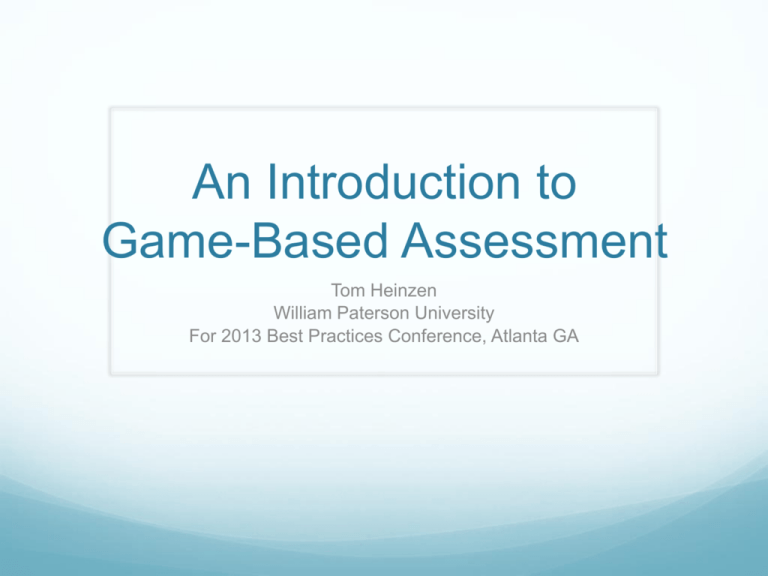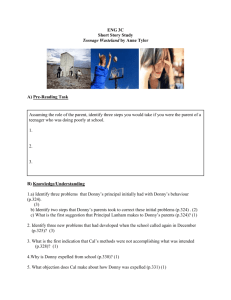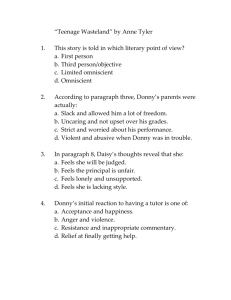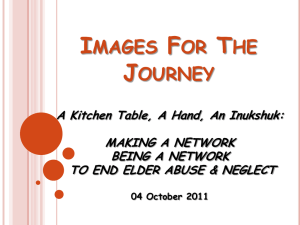The Principles of Game Design
advertisement

An Introduction to Game-Based Assessment Tom Heinzen William Paterson University For 2013 Best Practices Conference, Atlanta GA With thanks, for many different reasons, to D. A. Bensley, scale development S. O. Lilienfeld, scale development M. Gordon, experimental psychologist S. Richman, user experience specialist T. Shendervich, animator A Major Assumption: Students love being assessed. They just don’t like how we’ve been doing it. However, people do love to: a) compare themselves to others; b) overcome obstacles; and c) demonstrate mastery. People love to be assessed. Current approaches punish failure. But failure (like falling) is already its own punishment. Six Critical Definitions Assessment is the authentic evaluation of teaching and learning outcomes (See Dunn et al., 2011; Heinzen et al., in press; Schnell, 2008). Gamification is the application of principles of game design to nongame situations. Game-Based Assessment (GBA) applies principles of games to assess students’ skills and knowledge (in psychology). A game is a situation in which participants voluntarily try to overcome unnecessary obstacles (i.e. rules and goals). Play is the exuberant expenditure of energy in aimless activities. Fun is any intrinsically motivated, engaging activity. Gamification does not necessarily involve computer games! What are we trying to assess? The APA’s goals are for undergraduates to demonstrate… Scientific Inquiry and Critical Thinking Ethical and Social Responsibility Communication Professional Development Knowledge Base in Psychology What’s good about games? Games develop skills and promote cooperation. Games can be “hard fun.” Games are popular and familiar to students. Games are ancient; (multiple choice tests are not). Games are our present… Cityville launched in 2011 and went from 0 – 100 million users in 41 days. Video gaming is a 66 billion dollar industry (double Hollywood); online sales will surpass retail sales this coming year (in 2013). China is the biggest online market. > $8 billion was spent on supportive goods such as cyber seeds for Farmville. Successful games are NOT just about blowing stuff up: Sandbox (Minecraft) Building (Civilization, Sim City) Social Building (Farmville) MMOGs (World of Warcraft) Puzzles (Portal 2, Angry Birds) Vocabulary (Words With Friends) Games are in our future because… “We’re witnessing what amounts to no less than a mass exodus to virtual worlds and online game environments” (Economist Edward Castronova). The 10,000 Hour Principle has been at work for several years (Ericsson, Krampe, & Tesch-Romer, 1993). There are 500 million gamers who “are extraordinarily good at something” (Jane McGonigal’s TED talk). Gamers are already good at characteristics employers want: acting with urgent optimism (an “epic win” is always possible); weaving a tight social fabric (gaming requires and creates trust); experiencing blissful productivity (they are happier working hard at gaming); pursuing epic meaning (world of warcraft wiki is the second largest wiki in the world with 5 million users per month). Game Characteristics Fit a Liberal Arts Education (mostly from Nicole Lazarro) Games are hard fun that involve overcoming progressively more difficult obstacles. Games engage the entire person through ambiguity and incompleteness. Games create opportunities for meaningful growth through social comparisons, competition, cooperation, evaluated performance, and public spectacles. Games present ethical dilemmas. Why Now? • We have a growing base of students for whom playing games is the social norm. • Social media is already connecting people through games. • Game design in already being applied in non-game settings. This automatic feedback loop places drivers who obey the speed limit in a lottery funded by drivers who do not obey the speed limit. Who Are Gamers? (not necessarily peer-reviewed) You. (The average gamer is 30 years old). 44% of US/UK adults played a mobile game last month. 47% of players are female. 97% of 12-17 year olds play video games (in US/UK). The average student has chosen to spend as many hours gaming as they have spent in high school classes. Sources: Nicole Lazarro, Pres. of XEO Design, K. Werbach and Dan Hunter in For the Win, Lee Sheldon in The Multiplayer Classroom, Jane McGonigal in multiple TED talks, Gilman Louie of Alsop-Louie Partners. The Language of Game Design is Code for the Language of Psychology Badges are earned symbols of achievement that may provide prestigious titles and new abilities. Boss corresponds to an extremely hard challenge, such as a midterm, final, or some unexpected, bizarre challenge that must be overcome. Character Level – Each player starts completes missions to earn experience points to repeatedly level up his/her character. Checkpoint corresponds to progressively more difficult exams that offer a brief resting point. Easter Eggs are unexpected rewards that, like a variable schedule of reinforcement, create persistence. Epic Fail is a stupid failure at something that should have been easy to achieve. Epic Win is a rare, positive, major achievement such as earning an A in a difficult class or presenting at a conference. Experience Points are point rewards for many things ranging from staying in the game to specific achievements. Games create a situation in which participants voluntarily try to overcome unnecessary obstacles (outlined in our syllabi). Game design uses contrived contingencies that resolve with unequal outcomes by requiring meaningful choices that solve problems in ways that provide interpretable outcomes. Game Level is a particular achievement level within a game; like many textbooks, higher levels are more difficult and depend on achievements at lower levels. Glitch is an error in a course or game that allows people to cheat. (Designed glitches can be used to assess ethical behavior.) Leaderboards provide social comparisons in both courses and games that encourage competition and provide regular, meaningful feedback. Leaderboards provide social comparisons in both courses and games that encourage competition and provide regular, meaningful feedback. Leveling Up provides some sort of reward for the time you have invested, a recognized achievement at a higher level. Max Level (or Level Cap) is the highest possible achievement at which your character unlocks all of its abilities. Noob or Newbie is a new player who probably needs help because she or her does not yet understand the rules. Play is the expenditure of exuberant energy in aimless activities. Points in a game are calibrated more thoughtfully than many syllabi to take advantage of partial reinforcement to keep people motivated. Rage Quit (or Rage Out) describes a level of frustration that leads to leaving the class or dropping out of a game. Trolls and Trolling are social deviants within a game, people who take malicious pleasure (blowing things up) at making life difficult for others. Training Level A training level which corresponds to the first day of class when the rules of the game are discussed. So, students in a gamified course will …earn rewards by expending exuberant energy to overcome obstacles by making meaningful choices that solve real problems in order to achieve an epic win. Summary: Why might GBA work? 1. GBA provides prompt (automatic) feedback. 2. GBA provides motivating social comparisons. 3. GBA is scalable (100,000 psych majors/year). 4. GBA minimizes a fear of failure (you never really lose; you just start over). Social Comparisons 5. GBA is closer to a natural form of learning; 6. GBA can be simple (has face validity). 7. GBA can cross gender and ethnic groupings. 8. GBA blends extrinsic motivation (points) with intrinsic motivation (fun). 9. GBA captures optimal student performance. 10. GBA can be comprehensive (because students will spend many hours playing interesting games). Natural Learning Volkswagon Corp. is funding an approach to social change called Fun Theory. Many companies already monetize points. An unexpected airline upgrade is a game-designed Easter Egg. A Gamified Statistics Course Novice N | Competent C | Relational R | Skilled S | Expert E | Knowledge Creator KC Levels 1-6 (10 points each) Level 12-15 (30 points each) Types of Statistics Two-Way ANOVA Transforming Observations Understanding Interactions in Types of Variables Hypothesis Testing ANOVA Conducting a Two-Way BetweenGroups ANOVA Levels 7-11 (20 points each) The z Table Level 16+Project (50 points each) Assumptions Choosing the Appropriate Test Steps of Hypothesis Testing Applying the Appropriate Test Applying APA Style Some candid student comments after a gamified statistics course: Trial and error were good. There was no real help along the way, but there were no consequences. I like that we got to leave early if we learned all we needed to know for that week. I liked having someone other than the professor teach me; it was much better. (!) As professor, I was increasingly perceived as unnecessary to the learning process! When, if ever, did you experience something like an “epic win”? When I began to be able to do the material and solve problems alone. Whenever I finished a new level I felt that I accomplished it. Completing the practice tests and doing them correctly. Ancillary benefits flow out of good design. I inadvertently did several things well by Allowing high achieving others to teach other students Rewarding them with the privilege of leaving early (!) Giving them self-paced practice Keeping their attention for four hours each class Becoming more confident in the fairness of the tests, including when students deserved to fail Other data (from Gordon) suggest that More points = Greater motivation When students created the syllabus… Nothing but Bonus Points! Be the Teacher Time Attack King of the Hill Lottery System Group Cutthroat (WPU Students Justin Ali and Corey Sussman) Game design communicates a different attitude toward failure. Approach motivation “I've missed more than 9000 Fear & Withdrawal shots in my career. I've lost almost 300 games. 26 times, I've been trusted to take the game winning shot and missed. I've failed over and over and over again in my life. And that is why I succeed.” ~ Michael Jordan Two warnings: 1. The over-justification effect. 2. The faddishness of the education industry. Let’s play some games. (Sorry, they are still just story boards.) References Dunn, D. S., McCarthy, M. A., Baker, S. C., & Halonen, J. S. (Eds.) (2011). Using quality benchmarks for developing undergraduate programs. San Francisco, CA: Jossey-Bass. assessing and Heinzen, T. E., Landrum, R. E., Gurung, A. R., & Dunn, D. S. (in press). In Gamification for Business and Education (T. Reiners & L. C. Wood, Eds.), New York: Springer. Schnell, J. (2008). The art of game design. Boca Raton, FL: CRC Press. Suls, J., Martin, R., & Wheeler, C. (2002). Social comparison: Why, with whom, and with what effect? Current Directions in Psychological Science, 11, 159-163. Wu, Michael. Gamification from a Company of Pro Gamers. Retrieved January 14, 2012, fromhttp://lithosphere.lithium.com/t5/Building-Community-the-Platform/Gamification-from-a-Company-of-ProGamers/ba-p/19258 Se also Richard Bartle, Hearts, Clubs, Diamonds, Spades: Players who suit MUDs, http://mud.co.uk/richard/hcds.htm Additional information is available in Deloitte Consulting LLP (2012), "Tech Trends 2012: Elevate IT for digital business", www.deloitte.com/us/techtrends2012, Chapter 1. Additional information is available in Deloitte Consulting LLP (2012), "Tech Trends 2012: Elevate IT for digital business", www.deloitte.com/us/techtrends2012, Chapter 4. Additional information is available in Deloitte Consulting LLP (2012), "Tech Trends 2012: Elevate IT for digital business", www.deloitte.com/us/techtrends2012, Chapter 9. Each of the following three games represents just one of several games within a particular domain. Stat Wizard Game 1: Name That Test (Applying statistical knowledge) Review this decision tree about which hypothesis test to use in different situations. Sample decision tree (Appendix E): Only nominal variables Categorical Only scale variables Interval Question about association Question about prediction Regression Pearson Correlation One nominal variable Chi-square test of goodness-of-fit Nominal IV and Scale DV Two nominal variables Chi-square test of independence 1. The degree of association between any two scale measures. Z test Single sample t test Paired samples t test Independent sample t test Factorial ANOVA One-way withingroups ANOVA One-way betweengroups ANOVA Chi-square test for goodness of fit Chi-square test for independence Spearman rankorder correlation Wilcoxon signedrank test Mann-Whitney U test Kruskal-Wallis H test Pearson correlation Regression 2. A question about prediction using only scale variables. Z test Single sample t test Paired samples t test Independent sample t test Factorial ANOVA One-way withingroups ANOVA One-way betweengroups ANOVA Chi-square test for goodness of fit Chi-square test for independence Spearman rankorder correlation Wilcoxon signedrank test Mann-Whitney U test Kruskal-Wallis H test Pearson correlation Regression 3. Gender differences in the scaled variable of optimism? Z test Single sample t test Paired samples t test Independent sample t test Factorial ANOVA One-way withingroups ANOVA One-way betweengroups ANOVA Chi-square test for goodness of fit Chi-square test for independence Spearman rankorder correlation Wilcoxon signedrank test Mann-Whitney U test Kruskal-Wallis H test Pearson correlation Regression 4. The relation between gender and income in four different neighborhoods. Z test Single sample t test Paired samples t test Independent sample t test Factorial ANOVA One-way withingroups ANOVA One-way betweengroups ANOVA Chi-square test for goodness of fit Chi-square test for independence Spearman rankorder correlation Wilcoxon signedrank test Mann-Whitney U test Kruskal-Wallis H test Pearson correlation Regression Some Game Mechanics The ~ 40 questions gradually become more difficult, applied, and worth more points. Students achieve certification badges when they correctly answer subsets of questions: 4 levels; 4 badges. Students can take this exam until they earn 100%. In the background, we are measuring time to complete, number of attempts, and accuracy – and sending all that information to a spread sheet. It needs standard psychometric development (reliabilities and most of the validities). An empirical question: What is the most motivating game response to failure (a wrong answer) and success? Stinkin’ Thinkin’ The Job Interview (Distinguishing between types of variables) Stinkin’ Thinkin’ A newly graduated psychology major was running late for a job interview. Stinkin’ Thinkin’ While getting ready for the interview, she experienced a persistent intuition: Stinkin’ Thinkin’ Being late might not make a good first impression on the interviewer. Stinkin’ Thinkin’ He imagined sweating during his job interview. Stinkin’ Thinkin’ So he rushed out to his brand new car, Stinkin’ Thinkin’ …turned the key and guess what? Stinkin’ Thinkin’ The car wouldn’t start. Stinkin’ Thinkin’ Plus, her cell phone was dead… Stinkin’ Thinkin’ …and he noticed a small mustard stain on his tie. Stinkin’ Thinkin’ All in all, she just didn’t feel quite ready to drive to an important job interview. Stinkin’ Thinkin’ He felt discouraged... Stinkin’ Thinkin’ ….and frustrated… Stinkin’ Thinkin’ …so he started to think. Stinkin’ Thinkin’ How can I get my car to start? Stinkin’ Thinkin’ Before trying to start the car again, she experimented with several interventions such as… …staring at the engine with her mighty psychic powers… Stinkin’ Thinkin’ …slamming the hood… Stinkin’ Thinkin’ …hitting the steering wheel in frustration… Stinkin’ Thinkin’ …and screaming… Stinkin’ Thinkin’ …putting the key into the ignition very, very slowly… Stinkin’ Thinkin’ After doing all these things, he turned the key again, and guess what… Stinkin’ Thinkin’ The car started! Stinkin’ Thinkin’ The world seemed like a wonderful place once again! Stinkin’ Thinkin’ He felt like he would nail the interview! Stinkin’ Thinkin’ But he still had one burning question: Stinkin’ Thinkin’ What had caused the car to start? Stinkin’ Thinkin’ Examine the boxes on this page. Then click START and drag and drop each box into the appropriate column in the next slide. Work as quickly as you can until you have placed every box in the appropriate column. Screaming Using psychic powers Hitting the steering wheel Slamming the hood Ways to get the car to start The car starts or does not start One of these influences caused the car to start None of these influences caused the car to start One of these influences may have caused the car to start. Being worried about the interview Having a dead cell phone Worrying about sweating Putting the key in very slowly START Screaming Using psychic powers Hitting the steering wheel Slamming the hood Ways to get the car to start The car starts or does not start One of these influences caused the car to start None of these influences caused the car to start One of these influences may have caused the car to start. Being worried about the interview Having a dead cell phone Worrying about sweating Putting the key in very slowly Independent Variable(s) Dependent Variable(s) Alternative Explanation(s) Extraneous influence(s) A Logical Conclusion An Illogical Conclusion Stinkin’ Thinkin’ We need to a) Know how many attempts they made to get each correct answer b) Know how long it took. c) Tabulate accumulating points for correct answers. d) Assign bonus points for correct answers in a row. e) Create an anonymous leaderboard. f) Tabulate how often they switched answers. g) Provide a recognizable acoustic reward (“Ding!”?) for correct answers and a polite signal for incorrect answers. h) These are almost all manageable, empirical issues. Help Donny (Knowledge of Psychology) FairLawn, NJ Designed by Sam Richman (User Experience Strategist) The foundational scale was developed by D. Alan Bensley and Scott Lilienfeld and may not be used without their permission. Hello Counselor-in-Training, please enter your Name_______ Graduation Year______ (Other demographics; tbd) Welcome ________, meet Donny. Your new client, Donny, is a 21 year old Caucasian male, currently finishing up his bachelors in philosophy. Note to SR: The couch image is outdated so it doesn’t work, especially in a test of myths about popular psychology. TH Your task is to use your knowledge of scientific psychology, even if it contradicts your intuition, to help Donny make some Important life decisions. Description of Introduction 1. Buzzing noise 2. User opening the door to let Donny in 3. (User dialogue box) “Hello Donny, my name is _______” 4. (Donny) “Hi _________” 5. (User dialogue box) “So, Donny, what brings you here?” “I am stressed out about final exams and then leaving school. I don’t know what I want to do with my life, what I believe, or who I am. I am totally confused.” “For example, in my Philosophy class, my teacher tailored her teaching style to each students’ learning style. Will that help my test scores?” A) Well, Donny, I can’t know how you will score, but studies indicate that learning is best when a teaching style matches a learning style. B) Well, Donny, I can’t know how you will score, but studies indicate that matching teaching styles to learning styles has no effect on actual learning. “I’ve been feeling really down on myself lately. My father says I need to work on my self-esteem. Is building my selfesteem likely to help me earn higher grades?” A) I’m sorry Donny, but building self-esteem does not, on average, seem to help academic performance; your best bet is probably to study more. B) Your father is right, Donny. Raising your self-esteem is, on average, a proven method for improving academic achievement. “When I take a test, I keep second-guessing my answers. Should I go with my first impulse or is it better to go back over the answers?” A) Stick with your first hunch; you can almost always trust your intuition. B) Go over the questions you are worried about and change them if you think another answer might be better. “Am I bad at math because I’m left handed and right brained? Is that why math courses are so difficult for me?” A) It’s true, Donny. Right-brained people usually lean more towards the arts. Even if you’re not great at math, you are probably more creative than most left-brained people. B) That’s a myth, Donny. Which hemisphere of the brain is dominant doesn’t seem to matter. You probably just need to study more effectively. “Well, I finally graduated, but I still feel lost. I went on my 6th job interview and my father gave me a long lecture about my lack of ambition, blah blah blah. I am so angry, I could explode! What should I do?” A) Try punching a pillow. It will help you blow off steam and redirect your anger without actually harming anyone. B) Try listening to music or going for a walk. Distraction and self-control are better ways to manage your anger. “I’ve been very depressed for a long time and drug treatments don’t seem to help. What about electroconvulsive therapy?” A) Don’t do it, Donny! ECT is a dangerous, brutal, and primitive treatment and it won’t affect depression. B) Well, Donny, ECT can be an effective treatment that has been safely used to treat depression. “Guess what? I finally found a job and a small apartment far away from my father. Plus, during my coffee breaks, I keep running into this very attractive woman and discovered that we have the same tastes in music. She laughs at my jokes and even orders the same coffee drink!” “In fact, there’s another young, attractive woman in my apartment building. We don’t have much in common; she’s so different that I find her interesting. We disagree on movies, music, religion, and even politics!” “I want to ask one of them on a date, but I’m not sure which. I’d love to know your thoughts, I can’t stop thinking about it.” A) Well, Donny, studies support the folk wisdom that birds of a feather flock together. B) Well, Donny, studies support the folk wisdom that opposites attract. “So my date was a lot of fun, but I never knew what she wanted, like should I pay? Or did she want me to kiss her? Sometimes she’d just give me this look that I didn’t understand. Why don’t we communicate better?” A) Donny, when it comes to communication, men and women are far more similar than they are different. B) Donny, when men and women try to communicate, it’s like “men are from Mars and women are from Venus.” “I see the woman in my building all the time, now; I even had a dream about her. Is my subconscious trying to tell me she’s the one for me or was it just because I’ve spent more time with her?” A) It’s most likely your dream is simply due to the amount of time you have spent with her. B) It’s most likely your dream has important symbolic meaning indicating that she really could be the one for you. Two Possible Profiles of Donny After Section #1 – The gamer-therapist never gave the scientific response. Profile 1: Donny is not doing well in therapy. Donny has no job, no money, is depressed, and unmotivated. He can’t get into graduate school, and fights with his father and even with his few remaining friends. - He’s also in a bad relationship but won’t try to get out of it. Quality of Life The gamer-therapist gave the scientific response 5 out of 8 times. Profile 2: Donny is making some progress in therapy. Donny has a job, is saving money, is less depressed, and more motivated. He still fights with his father but is making plans to take charge of his future. - He’s in a relationship that has both ups and downs and is more willing to work at it. Quality of Life Critical Advantages of GBA Over Multiple Choice Tests: GBA conforms to standard psychometric practice by using multiple types of measures multiple times. GBA captures student performance when participants are motivated to do their best. GBA can be played enthusiastically for many hours over many days, controlling for transitory influences. GBA allows comprehensive assessment across many domains rather than cramming four years of learning into a 3-hour MC test. GBA provides many opportunities to demonstrate diverse skills in varied applied settings. Thank you. Questions and comments?







